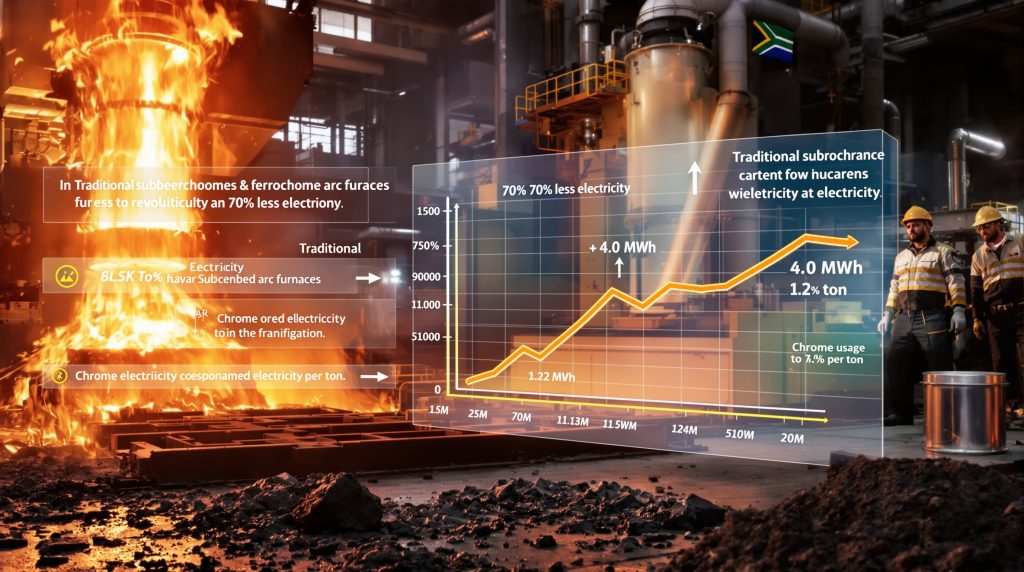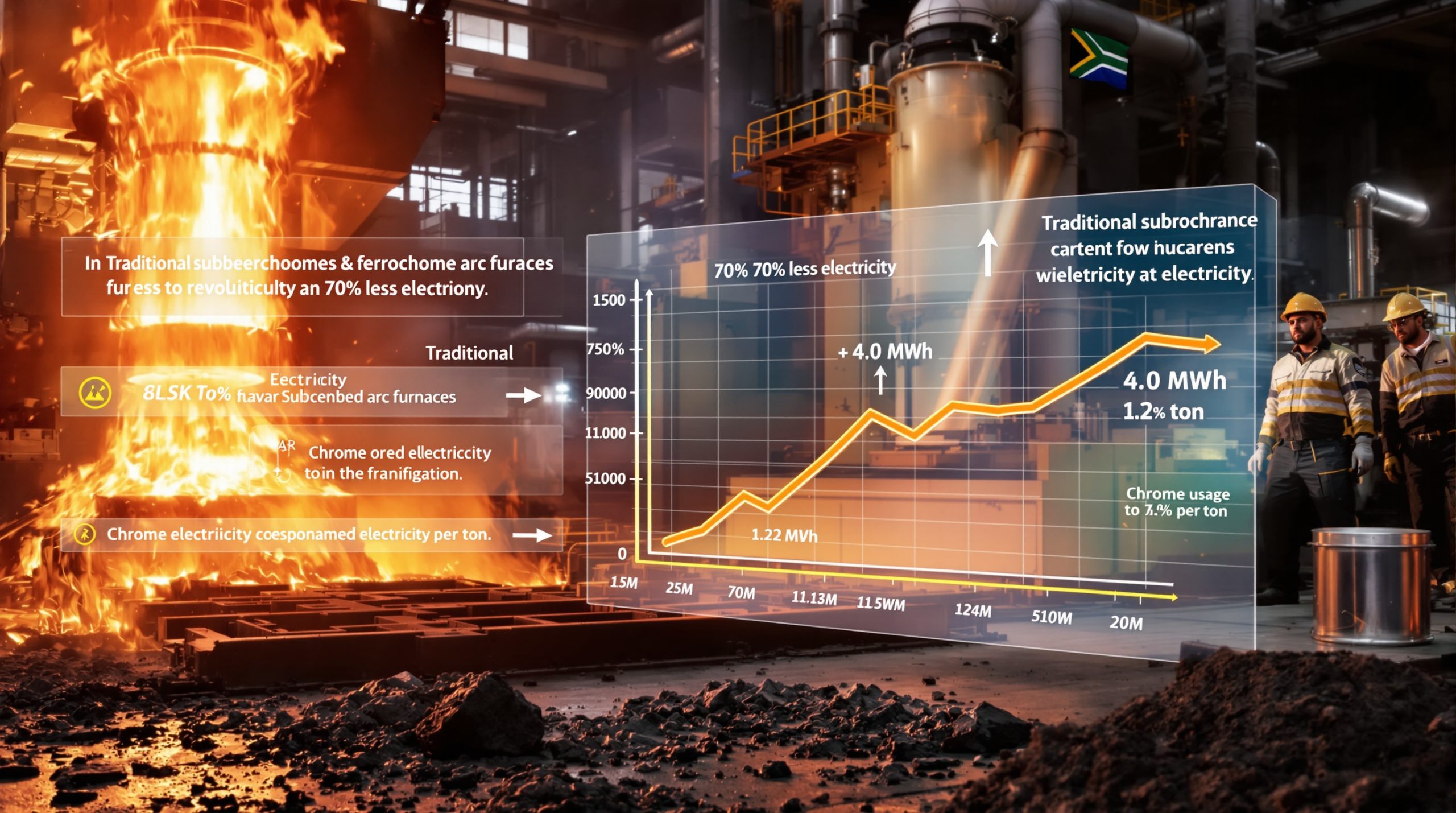Revolutionizing Ferrochrome Production: South Africa's Innovative Smelting Technologies
South Africa's ferrochrome industry stands at a critical juncture. Despite controlling nearly three-quarters of global chrome reserves, the country has seen its share of ferrochrome production decline dramatically in recent years. This paradox represents both a challenge and an opportunity for the nation's mining and metallurgical sectors.
The primary culprit behind this decline has been spiraling electricity costs. However, breakthrough South Africa's mineral beneficiation and smelting technologies offer a promising path forward, potentially revitalizing an industry vital to South Africa's economy.
How Has South Africa's Ferrochrome Industry Been Challenged?
South Africa possesses approximately 72% of the world's chrome ore reserves, yet its global market share in ferrochrome production has fallen precipitously from around 50% in the early 2000s to less than 30% today. This decline stems primarily from escalating electricity costs, with Eskom's tariff increases making production increasingly uneconomical.
According to the Minerals Council South Africa, electricity tariffs increased by approximately 307% between 2008 and 2023, dramatically altering the production economics of this energy-intensive industry. This has placed South African producers at a significant disadvantage against international competitors, particularly those in Kazakhstan and China.
The consequences have been severe across multiple dimensions:
- Multiple smelters have been idled or permanently closed, including significant operations in Rustenburg and Middelburg
- Raw chrome ore exports have increased by 15% between 2020-2023 while value-added ferrochrome production declined by 8%
- Thousands of high-paying jobs have been lost in both direct smelting operations and supporting industries
- Foreign exchange earnings have decreased, contributing to balance of payment challenges
Mining analyst Peter Major notes that "South Africa's downward trajectory in ferrochrome production represents one of the clearest examples of how electricity constraints can undermine natural competitive advantages in resource processing."
What Makes Electricity Costs So Critical for Ferrochrome Production?
Electricity consumption represents approximately 40-45% of ferrochrome production costs in South Africa. This high energy intensity makes the industry particularly vulnerable to electricity price fluctuations and supply reliability issues.
Traditional smelting technologies typically require 3.5-4.0 megawatt-hours (MWh) per ton of ferrochrome produced, which translates to significant operational costs. The Chamber of Mines Cost Structure Analysis shows that for every 10% increase in electricity tariffs, production costs rise by approximately 4-4.5%.
The disadvantage becomes even more pronounced when comparing international electricity costs:
- South African producers currently pay approximately $0.12-0.15 per kWh
- Kazakhstan producers benefit from electricity costs of $0.04-0.06 per kWh
- Chinese producers receive various provincial subsidies, effectively reducing their electricity costs
Beyond the direct cost impact, load shedding and unreliable power supply have created additional challenges. Ferrochrome smelters operate optimally with continuous power supply, as interruptions can cause refractory damage and costly restart procedures exceeding R10 million per incident.
Metallurgical consultant Dr. James Robinson explains: "The economics of ferrochrome production are fundamentally tied to energy efficiency. Countries that can provide reliable, cost-effective electricity have a tremendous advantage, regardless of their chromite resources."
What Traditional Ferrochrome Technologies Are Used in South Africa?
South Africa employs several conventional ferrochrome smelting technologies, each with distinct characteristics and efficiency profiles.
Submerged Arc Furnace (SAF) Technology
The most widely deployed technology in South Africa's ferrochrome industry, submerged arc furnaces remain the backbone of production:
- Uses three electrodes submerged in the furnace charge material
- Generates heat through electrical resistance as current passes through the charge
- Typically consumes 3.5-4.0 MWh per ton of ferrochrome
- Requires significant quantities of carbon reductants (approximately 550-650 kg per ton)
- Electrode consumption averages 4-6 kg per ton of ferrochrome produced
- Furnace diameters typically range from 12-16.5 meters in South African operations
The Outotec Process
This Finnish-originated technology has been implemented in several South African operations:
- Features pelletized chrome ore feed for improved efficiency
- Incorporates pre-heating stages to reduce energy consumption
- Achieves moderate reductant consumption compared to basic SAF
- Still requires relatively high electricity (3.2-3.8 MWh/ton)
- Offers improved environmental controls over basic SAF technology
The Premus Process
Developed and implemented by Glencore Alloys, this more advanced process represents a significant efficiency improvement:
- Utilizes pelletized chrome ore with carbon
- Incorporates pre-reduction kilns that partially reduce the ore before smelting
- Achieves lower electricity consumption (approximately 2.4-2.8 MWh/ton)
- Reduces carbon reductant requirements by approximately 20%
- Requires higher initial capital investment but delivers lower operating costs
DC Arc Furnace Technology
Employed by companies including Samancor and other producers, DC arc furnaces offer distinct advantages:
- Features a single electrode design rather than three electrodes used in SAF
- Provides more precise temperature control for consistent product quality
- Improves energy efficiency by approximately 10-15% over basic SAF
- Enables processing of lower-grade ore materials and fines
- Requires sophisticated control systems and higher technical expertise
What Breakthrough Technologies Are Transforming South African Ferrochrome Production?
The New Low-Energy Smelting Process: A Game-Changing Innovation
South Africa has developed proprietary smelting technology that dramatically reduces electricity requirements by approximately 70%. This process represents a significant breakthrough for the industry:
- Energy Efficiency: Requires only about 1.2 MWh per ton of ferrochrome, compared to 4.0 MWh for conventional methods
- Carbon Footprint: Substantially reduces carbon emissions through lower energy and reductant consumption
- Feedstock Flexibility: Can effectively process lower-grade chrome ores that would be uneconomical with traditional methods
- Integration Potential: Compatible with renewable energy sources and bio-reductants
- Cost Advantage: Significantly lowers production costs, potentially restoring South Africa's competitive position
This technology has undergone extensive testing with promising results. The process incorporates innovative pre-reduction techniques combined with advanced furnace design that fundamentally changes the energy dynamics of ferrochrome production.
"South Africa's ferrochrome revival hinges on embracing these innovative technologies while also addressing the broader challenges facing the industry," according to recent industry analysis.
Modernized Furnace Refurbishment Projects
Beyond new technology development, significant efforts are underway to modernize existing smelting operations through mining innovation trends that include:
- Multiple furnace complexes are undergoing comprehensive upgrades
- Electric arc furnaces are being retrofitted with improved energy efficiency systems
- Advanced digital control systems are being implemented to optimize operations
- By-product recovery systems are being enhanced to extract valuable elements like vanadium and titanium from slag
These refurbishment projects aim to improve operational efficiency while extending the lifespan of existing assets, bridging the gap between conventional technology and revolutionary new approaches.
How Do South African Ferrochrome Technologies Compare Globally?
When benchmarked against international competitors, South Africa's technological innovations show significant promise across multiple parameters within the global mining landscape overview:
| Technology | Energy Consumption (MWh/ton) | Carbon Intensity | Feedstock Flexibility | Capital Requirements | Operating Costs |
|---|---|---|---|---|---|
| Traditional SAF (South Africa) | 3.5-4.0 | High | Moderate | Moderate | High |
| Outotec Process (South Africa) | 3.2-3.8 | High | Moderate | Moderate-High | High |
| Premus Process (South Africa) | 2.4-2.8 | Moderate | Good | High | Moderate |
| DC Arc Furnace (South Africa) | 2.8-3.2 | Moderate | Good | High | Moderate |
| New Low-Energy Process (South Africa) | ~1.2 | Low | Excellent | Moderate | Low |
| Chinese Furnace Technology | 3.4-3.8 | Very High | Limited | Low | Moderate |
| Kazakhstan Technology | 3.3-3.7 | High | Moderate | Moderate | Low |
The new low-energy technology demonstrates South Africa's potential to leapfrog competitors through innovation, potentially reclaiming market share lost to international producers.
Industry analyst Rebecca Thompson observes: "If successfully commercialized at scale, South Africa's new smelting technology could fundamentally alter global ferrochrome production economics, leveraging the country's vast chrome resources with a technological advantage that others cannot easily replicate."
What Environmental Benefits Do Advanced Ferrochrome Technologies Offer?
Modern ferrochrome smelting technologies deliver significant environmental improvements that align with electrification and decarbonisation trends:
Emissions Reduction
- Greenhouse Gases: Energy-efficient technologies like the new low-energy process can reduce carbon emissions by up to 65% compared to conventional methods
- Particulate Matter: Advanced filtration systems capture over 99% of dust emissions, compared to 95-97% in older systems
- Sulfur Compounds: Modern gas cleaning systems significantly reduce SO₂ emissions to nearly undetectable levels
Resource Efficiency
- Water Usage: Closed-loop water systems reduce freshwater consumption by up to 80% compared to older operations
- Material Recovery: Advanced slag processing recovers valuable metals that would otherwise be wasted, increasing effective resource utilization
- Land Footprint: More efficient processes require less land area per ton of production, minimizing environmental disruption
Waste Management
- Slag Utilization: New technologies enable conversion of slag into construction materials and cement additives
- Gas Recovery: Carbon monoxide capture for energy generation reduces both emissions and energy costs
- Dust Recycling: Recovery and reprocessing of captured furnace dust extracts valuable metals and reduces waste disposal
Environmental consultant Dr. Sarah Mokoena notes that "the new generation of ferrochrome technologies represents a dual opportunity for South Africa: revitalizing a crucial industry while simultaneously addressing environmental concerns that have historically challenged the sector."
What Economic Impact Could Revitalized Ferrochrome Production Have?
Implementing advanced smelting technologies could substantially benefit South Africa's economy across multiple dimensions:
Direct Economic Benefits
- Employment: Revitalization of idled smelters could create or preserve thousands of direct jobs in areas with limited alternative employment
- Export Revenue: Increased ferrochrome production could generate billions in additional annual export earnings, strengthening South Africa's balance of payments
- Tax Revenue: Expanded operations would contribute significantly to both national and local government revenue through corporate taxes, royalties, and employee income taxes
Indirect Economic Benefits
- Supply Chain: Strengthened demand for supporting industries including mining, logistics, and maintenance services creates a multiplier effect throughout the economy
- Skills Development: Advanced technologies require workforce upskilling, creating higher-value employment opportunities in technical and engineering roles
- Infrastructure Utilization: Improved utilization of existing rail, port, and power infrastructure enhances returns on historical public investments
Strategic Benefits
- Resource Beneficiation: Moving up the value chain from raw ore exports to processed ferrochrome aligns with national development goals
- Industrial Capability: Maintaining and enhancing South Africa's industrial manufacturing base preserves crucial metallurgical knowledge and skills
- Technology Leadership: Positioning South Africa as a leader in metallurgical innovation creates opportunities for technology export and licensing
According to economic analyst Dr. Thabo Mhlongo, "The revitalization of South Africa's ferrochrome industry represents more than just jobs and exports—it's about maintaining industrial capabilities that once lost, are extraordinarily difficult to recover."
What Policy Support Is Needed for Technology Implementation?
Successful implementation of advanced South Africa ferrochrome smelting technology requires supportive policy frameworks across several domains:
Energy Policy Considerations
- Electricity Pricing: Competitive and stable electricity tariffs for energy-intensive industries through potential special economic zones or negotiated pricing agreements
- Renewable Energy Integration: Frameworks that enable ferrochrome producers to access renewable energy through direct procurement or self-generation with reduced regulatory barriers
- Energy Efficiency Incentives: Programs that reward investments in energy-efficient technologies through tax incentives or accelerated depreciation allowances
Investment Incentives
- Tax Allowances: Enhanced capital allowances for investments in advanced smelting technologies, similar to those historically offered for aluminum smelting
- Research and Development Support: Funding for continued technological innovation in metallurgical processes and carbon reduction technologies
- Skills Development Programs: Support for training workers in new technological processes through industry-education partnerships
Regulatory Framework
- Environmental Permitting: Streamlined processes for environmentally superior technologies that recognize their improved impact profile
- Export Controls: Potential measures to encourage local beneficiation of chrome ore through graduated export taxes or quotas
- Infrastructure Access: Ensuring reliable access to transport and energy infrastructure through coordinated planning and investment
Policy expert Professor Nomsa Dlamini suggests that "South Africa needs an integrated industrial policy approach that recognizes the strategic importance of the ferrochrome value chain and provides appropriate support without creating market distortions or unsustainable subsidies."
What Are the Implementation Challenges for New Ferrochrome Technologies?
Despite their promise, advanced smelting technologies face several implementation hurdles that must be addressed:
Technical Challenges
- Scale-Up Risk: Moving from pilot to commercial scale presents engineering challenges related to material handling, heat management, and process control
- Process Integration: Incorporating new technologies into existing operations requires careful planning to minimize disruption and optimize outcomes
- Operational Reliability: Ensuring consistent performance under production conditions across varying ore qualities and operating parameters
Financial Challenges
- Capital Requirements: Significant investment needed for technology deployment, potentially exceeding R5 billion for large-scale implementations
- Return Uncertainty: Market volatility creates uncertainty about investment returns, complicating financing decisions
- Funding Access: Limited availability of patient capital for industrial innovation, especially in an industry with historical profitability challenges
Market Challenges
- Global Competition: Continued pressure from international producers, particularly in China, may limit price recovery
- Market Acceptance: Customer validation of products from new processes requires time and testing
- Price Volatility: Ferrochrome market fluctuations affecting investment decisions and operational planning
Metallurgical engineer Thulani Nkosi emphasizes that "the technical challenges of new smelting technologies shouldn't be underestimated, but they're surmountable with proper planning, investment, and industry collaboration. The bigger challenges often lie in securing the necessary capital and maintaining operational focus during implementation."
What Is the Future Outlook for South Africa's Ferrochrome Industry?
The outlook for South Africa's ferrochrome sector depends largely on technology adoption, market conditions, and policy support:
Short-Term Prospects (1-3 Years)
- Continued pressure from high electricity costs with selective implementation of efficiency measures
- Gradual implementation of energy-efficient technologies at existing operations
- Selective restart of idled capacity as conditions improve, particularly for operations with access to renewable energy
- Initial commercial validation of new low-energy smelting technologies
Medium-Term Outlook (3-7 Years)
- Broader deployment of advanced smelting technologies as validation data becomes more robust
- Improving competitive position as energy efficiency increases across the industry
- Potential recovery of market share from international competitors, particularly in premium product segments
- Integration of renewable energy sources to further enhance cost competitiveness and environmental performance
Long-Term Vision (7+ Years)
- Establishment of South Africa as a technology leader in ferrochrome production with competitive production costs
- Integration with renewable energy sources creating a sustainable, low-carbon ferrochrome industry
- Development of advanced chrome alloys and specialized products to maximize value addition
- Potential expansion into related value chains, leveraging technological advantages
Industry veteran Michael Botha observes that "the future of South Africa's ferrochrome industry will be determined not by its resource advantage, which has always been present, but by its ability to innovate and adapt to changing energy and environmental realities."
Technology as the Key to Ferrochrome Revival
South Africa's ferrochrome industry stands at a technological crossroads. While conventional smelting methods struggle with high electricity costs, innovative technologies that dramatically reduce energy consumption offer a path to renewed competitiveness and sustainability.
By reducing energy consumption by up to 70%, these technologies could transform the economics of ferrochrome production in South Africa, allowing the country to leverage its abundant chrome resources more effectively. Beyond economic benefits, this technological revolution promises improved environmental performance and sustainable mining transformation.
The successful implementation of these technologies requires coordinated action from industry, government, and investors. With appropriate support, South Africa can reclaim its position as a global ferrochrome leader while building a more sustainable and competitive industry for the future.
Disclaimer: The ferrochrome market remains subject to significant price volatility and competitive pressures. Investments in new technologies, while promising, carry inherent risks related to implementation, market acceptance, and competitive response. This article presents analysis based on current information, but conditions may change rapidly in this dynamic global industry.
Ready to Spot the Next Major Mineral Discovery?
Discover why significant mineral discoveries can lead to substantial market returns by exploring Discovery Alert's dedicated discoveries page, where our proprietary Discovery IQ model instantly alerts investors to high-potential ASX mineral announcements, giving you the market advantage before others react.




